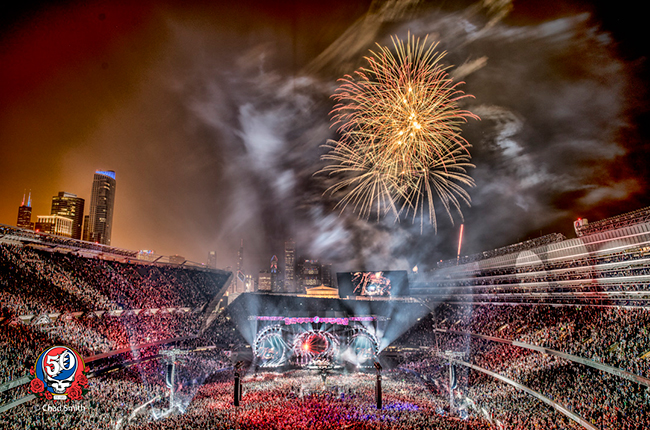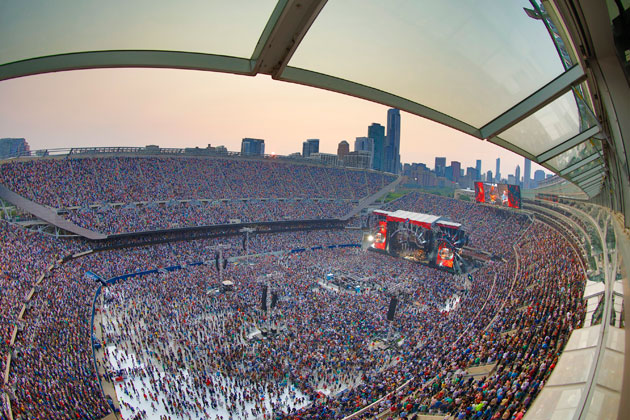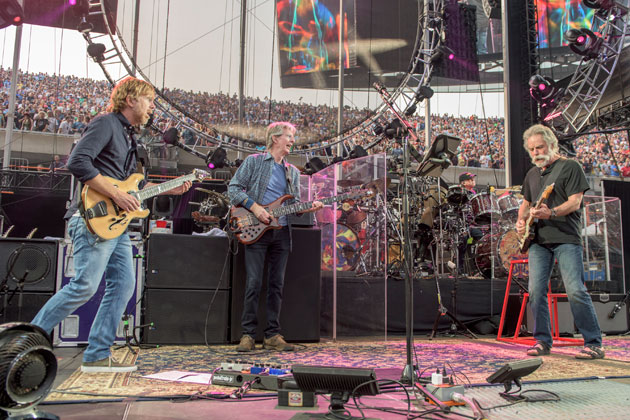
I was born in 1973. The Grateful Dead had already been an entity for 8 years, having travelled thousands of literal, and millions of psychic, miles by the time I’d breathed my first.
By the time I first saw Jerry Garcia he'd already faced down a diabetic coma, written just about all of his most impressive compositions, and led his band(s) to mind boggling levels of artistic and commercial success.
He was indeed worse for wear, but I wouldn't trade a minute of the 22 nights I got to spend with the man for anything. Learning, exploring and experiencing the Grateful Dead, even in the 90s, put me in touch with something so huge and universal, its no wonder that those moments can continually be mined for new and exciting insights.
I say this even as I discovered, almost simultaneously, another band that would inspire similar levels of dedication and obsession. When I climbed aboard the Phish train, they couldn't have been more opposite of where the Dead were in their career -- pouring so much creative energy into their craft to the point where they'd become the most daring, most innovative, most prolific versions of themselves -- and I had a (figurative and sometimes literal) front row seat for all of it.
So while I entered the University of Improvisational Music as a GD major, it was in Phish studies that I earned my advanced degree, with copious amounts of field work.
When people would ask which band was my favorite, I'd answer: "That's like a parent picking his favorite child." That was before I had kids of my own, but now that I do, I can honestly say it's exactly like that.
I'm Not Alone
Surely not everybody who would claim Grateful Dead and Phish as their two favorite bands has the same story as me, but it is evident that there are many who will find some version of themselves in the narrative.
So when rumors began to swirl in the winter of 2015 about The Dead reuniting with Trey Anastasio playing the lead guitar, it was a slippery slope from joy and hopefulness to outright mania.
All other things being equal — the 50th anniversary, the "final shows", the stadium, the mail order, the fourth of July — it was Trey's involvement that struck the most resonant chord.
For nearly six months, it was fun to joke about, speculate, analyze, and criticize what it might sound like. But until I was in Soldier Field, hearing Trey's notes ring out amongst the truly huge sound of the seven-piece band, did it finally hit me — this was not Trey filling Jerry’s shoes. Nobody can do that. This was Trey doing his level best to create something worthy of the band’s incredible legacy, to acknowledge its history, its fans, its traditions, but also its reason to exist.
At its very best, this band sounded not like the Grateful Dead of old, but a sleek Dead / Phish hybrid. With years of in-fighting and ugliness amongst the “core four” prior to these runs, Trey implanted his personality onto an operation desperately in need of one. Yet, it was done humbly, respectfully and not overbearingly.
It Had To Be Trey
It just had to be.
As maddening as it was in the run up to the shows. These gigs had to sell out. They had to be the tough ticket. Everybody in there had to be so. fucking. happy. that they were in the building. There had to be people seated behind the stage. This thing had to break all the webcast records.
They were concerts, yes, but also a statement about fifty years of culture, community and music. In an industry gradually slipping into LiveNation / Lollapalooza / Coachella generi-malaise. We needed to rise up again and be the talk of the town.
And only Trey could deliver that. Only he could channel the zeitgeist of two rabid fan bases. Yes, it was a straight up hype job and truly inspired casting by Peter Shapiro and friends.
But then something truly incredible happened. Anastasio rose to the occasion.
Having seen Phish at their peak, I’m also willing to admit that the latest incarnation of the band, though capable of producing some incredible individual shows, haven’t been at quite the America-destroying pace of their nineties heyday.
I think a lot of that comes down a reduction in hours: less time spent together, less time in the practice room, and less time doing deliberate, challenging exercises intended to break new ground.
But the size and visibility of Fare Thee Well forced Anastasio back into the practice room. Famous for learning another band’s albums at Halloween gigs in the past, Trey went for broke and essentially learned 10 albums.
And, sure, Trey has played with the members of the Dead before, but always as an “extra” guitar. The famed Phil and Friends 1999 run featured Steve Kimock, who certainly owned his shared of the highlights.
But for Fare Thee Well, Trey was the lead. Some of his familiar phrases and licks found themselves integrated into the most beloved songs of all time.

Stadiums Are No Place To See A Show, These Shows Could Only Be In A Stadium
Make no mistake, as a music venue Soldier Field was obscenely large, impersonal, and logistically impractical. A great portion of the audience was seated city blocks away from the performers.
But somehow, that only added to the experience.
It was a throwback, for sure. For people like me in the 90s, seeing the Dead in a football stadium during the summer was practically the only option.
But, I count the number of stadium shows I’ve seen since July 9, 1995 on one hand.
Their recent Wrigley Field experience aside, Phish has maxed out at the amphitheater level (and seems to be trending downward) and mega festivals tend to diffuse the attention from any given act, even headliners,
It wouldn’t have been the same in a field, in the middle of nowhere. A Bonnaroo or even Peter Shapiro’s Lockn’ Festival.
You needed walls to confine the energy. It had to be important to get a ticket. But it also had to be huge, larger than life. Thankfully, the enormity and, improbably, beauty of the stage and production put this all into perspective. And the sound? Even in the back, totally engrossing. Everybody felt a part of the action.
The Grateful Dead Was a 30 Year Adventure, Celebrating 50
From the Santa Clara shows through Soldier Field, Fare Thee Well was an open, poignant love letter to the thing that was Grateful Dead. Every era of the adventure was represented in the setlist of every show, from primal Dead psychedelic goodies, to the new jamband “standards” to the nineties songs of reflection and mortality.
At 50, more than ever, Grateful Dead represented whole, fulfilling life.
Throughout those twenty Garcia-less years, side projects, reunions and offshoots existed as touring entities, developing a repertoire and taking the show on the road. Fare Thee Well at its core was fleeting — and like the Grateful Dead, finicky and unknowable.
Playing five shows without repeating a song would signify something, so of course they didn’t. Having Phil and Bobby be on the exact same musical page would tie a nice bow on their story, but at times they were visibly at odds. But, it’s tension like that that makes great music, and these shows were made stronger amidst on and off stage drama.
Hornsby and Chimenti were two keyboardists working in tandem, bridging the gap between the Jerry years and the present, each bringing elements of the long strange trip into the fold.

From Counter Culture To Music Culture
With the publicity machine rolling, there was no shortage of recollection or full blown retrospectives in the media that focussed on the band’s earliest days. In most of these Grateful Dead is inherently linked with counter culture: hippies, LSD, alternative lifestyles, youth blazing new social trails in the face of establishment.
Counter-culture will likely always live on in some form, but has little to do with the Grateful Dead in the 21st century. The band has, however, helped to birth another cultural experience, with the music itself at the heart of it. It’s a mix of art, community and commerce, a set of loosely affiliated, barely acknowledged, undocumented behaviors that gives people identity, wrapped in their favorite music. Much of began with the Dead, was carried on with Phish, and is present in other jambands and even beyond.
The lot. Fan made art and merchandise. Pre-and-after show experiences. How we dress, act, and interact with each other. What audiences expect and what and how artists deliver.
Fare Thee Well helped to bring all of that into crisp focus.
Just recall the ticket situation — instant sellouts, massive markups, outrage. Yet remarkably, almost everybody I know got in to at least one of the shows.
A lot of that was due to the demand to experience this awesome thing. It was great to have the music world focussed on something like it — I kind of want another one.
And I want it to be in Chicago, which, incidentally, was the perfect city for this type of gathering, with its central location, wide open public spaces, and infrastructure prepared to handle events (and an entire cottage industry) of this magnitude.
So Was It The Grateful Dead?
Well, the easy thing to do is to label it that. Certainly it grabs more headlines that Fare Thee Well, Dead50, GD50 or whatever brand that was put out there to market it — the ubiquity of which (that Steal Your Face 50 logo, the skeleton in front of skyline Fare Thee Well design, the 50 dollar bill motif) was actually pretty impressive.
When Billy and Mickey took their drum solos it sure sounded like it.
When Phil’s bass broke free of whatever song was containing it, likely for the last time with those guys… I knew it’d be the last gasp of something.
All I know is that we were a part of something huge. Honestly, I can say I’ve never seen so many happy people. So there’s that.
Does it musically stand the test of time?
Looking a year back in the rear view mirror, I still remember 7/3 as a show and 7/5 as a moment.
Friday had the impeccable setlist (a parade of really big tunes and sentimental moments in equal measure), some real interesting improv and some showcase guitar work by Anastasio. I’d have never guessed before these shows, but I’ll even find my self listening back on occasion.
Sunday was heavy with 50 years of weight and expectations. Nothing performed could possibly have punctuated the career, no setlist could have been “perfect”.
But what they did choose did seem to harbor meaning. An opening "China > Rider". A jammed out "Cassidy". Both "Not Fade Away" and "Touch Of Grey" speaking directly to the experience.
And, oh, that “Attics Of My Life”. A tough one to pull off without Jerry in any case, no less in such a high leverage situation.
As the archival photographs of band members past and present were shown on the video screens, Soldier Field became awash in emotion. Bob Weir likes to speak about Garcia always being there with him when he performs, looking over his shoulder. It's his go-to anectdote about his friend and musical foil, and twenty-one years later. An acknolwedgement of his importance and sign of respect wrapped up in spectral mythology.
In that moment, Jerry was there for 70,000 strong. And probably millions more around the world watching from home and public spaces.
Fare thee well.